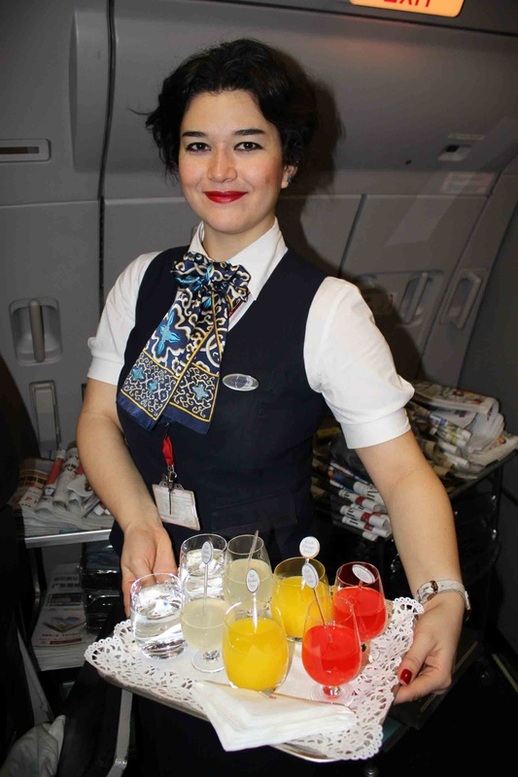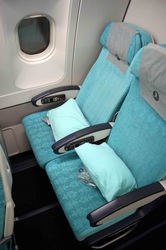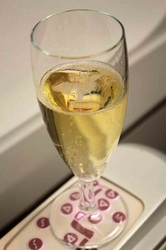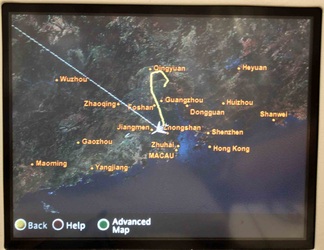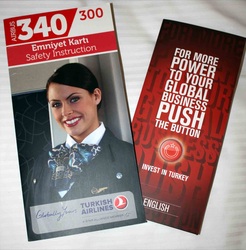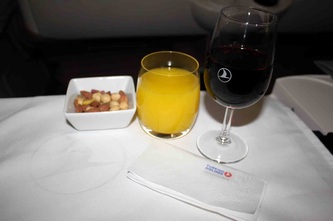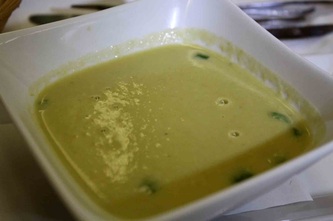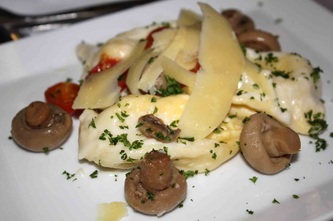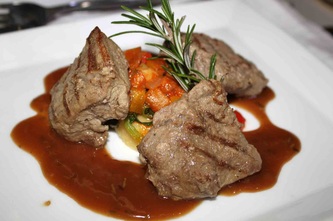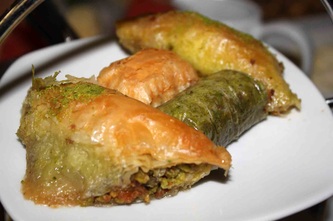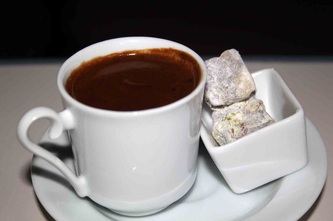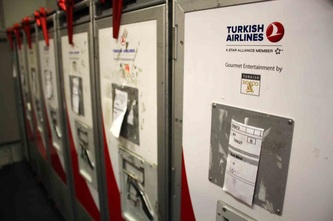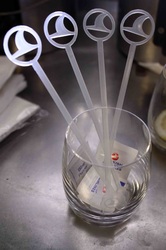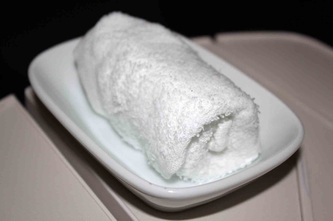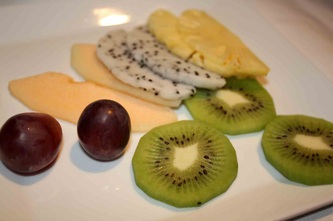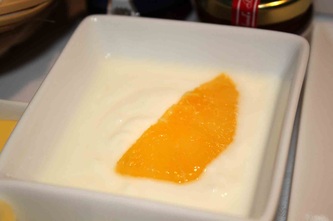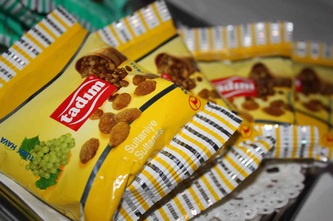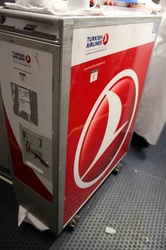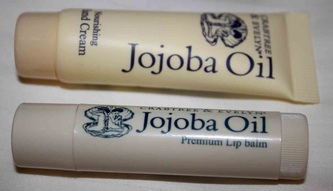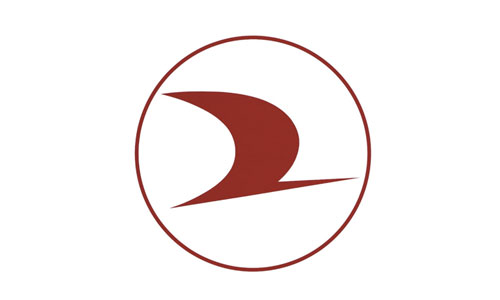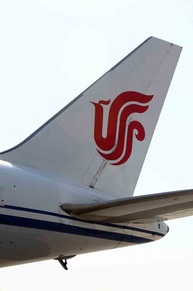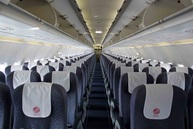|
THY Turkish Airlines is the award-winning national flag carrier of Turkey. Since being formed on 20th May 1933 with a fleet of 5 aircraft, Turkish Airlines has become a leading global airline company in its 80 years of distinguished service. Turkish Airlines is a proud member of Star Alliance, and operates from its global hub at Istanbul International Airport to 260 cities in 90 countries using 200 state-of-the-art aircraft. Turkish Airlines, which is a fully scheduled airline, carried 29.1 million passengers in 2010. It employs more than 14,000 people worldwide. In 2010, Turkish Airlines celebrated its 75th anniversary with a special ‘75’ logo painted on its aircraft and painted some its A320 aircraft in the old original 1970s airline livery. The initials 'THY' stand for Türk Hava Yollari (meaning Turkish Airlines). Turkish Airlines now officially flies to more destinations globally than any other airline. In December 2012, Turkish Airlines finalized an order for 15 Boeing airplanes that will help it fly to more destinations globally. The order was valued at $4.7 billion at list prices although customers buying multiple planes often get a discount. Turkish Airlines currently has 12 777-300ERs and nearly 100 Boeing airplanes. The 777-300ERs seat up to 386 passengers in each individual aircraft. The airline invest a lot of money in working with big brands and prompting its own brand too. Recent announcements in 2012 solidified Europe’s Best Airline’s Partnership with global sports figures. For example, International soccer superstar Leo Messi was named Global Brand Ambassador for Turkish Airlines at a ceremony in September 2012 at the Camp Nou Stadium in Barcelona, Spain, after signing the agreement. The FC Barcelona forward joins the ranks of Los Angeles Lakers star Kobe Bryant and professional tennis player Caroline Wozniacki who have been brand ambassadors since 2011 and 2010 respectively. In contrast to other European flag carriers in the 21st century, Turkish Airlines is proud to be the fastest growing airline in Europe and has been consistently been voted the best airline in Europe by its passengers and officially by SKYTRAX. The Guangzhou (CAN) to Istanbul (IST) route is a successful route, having started in February 2011. For this route, Turkish Airlines used to fly the brand new Boeing 777-300ER aircraft, however for the moment the airline uses the Airbus A340-300 aircraft. With the world’s major airlines focusing on cost cutting, it is no wonder that we are seeing a demise of the First Class cabin. So likewise, Turkish Airlines also has Business, Comfort Class (Premium Economy cClass- not on this aircraft), and Economy Class. Many major flag-carriers around the world are replacing their First Class cabins with Business Class (Virgin Atlantic, Air China, Continental Airlines are prime examples), and intact replacing their Business Class with Premium Economy Class cabins. Which does make sense because there is hardly much difference between First and Business Class, especially when most Business Class seats transform into flatbeds anyways. The Guangzhou to Istanbul route has become exceedingly popular with both Turkish and Chinese people because of the warm economic, political and tourist relations between Turkey and China. Presently there are four flights a week from Guangzhou to Istanbul and vice-versa (the last time I did a review for the CAN-IST route, it was only 3 flights a week). The flight from Guangzhou leaves at 23:10pm and arrives the following day at Istanbul at 5:25am, while the return flight leaves Istanbul at 23:50pm, arriving into Guangzhou the following day at 14:30pm. Most of the flights, including the one I took here (TK73) are full payload and full cargo as well. This gives the reader a strong indication of the strong partnership between Turkey and China, and the way the future of the aviation industry is going for these two countries. Both Turkey and China have ambitions plans in the pipeline to grow their aircraft fleets and airline routes for the commercial aviation sector between these two countries. In China, apart from Guangzhou, Turkish Airlines also flies to Shanghai, Beijing, and Hong Kong providing 25 flights a week to the region. Another strong indicator of this is that because Turkish Airlines is a proud member of Star Alliance, whose members also include Lufthansa, United Airlines, Shenzhen Airlines, Singapore Airlines, and Air China. So therefore, because of this link with Star Alliance, this flight was in code share with ‘Air China’. Focusing on Turkish Airline’s Business Class, incidentally – isn't difficult, however, especially once you’re on board. The cabins and service are top-notch, and you’ll definitely travel in sheer comfort. Enjoy the flight experience! Route: GUANGZHOU (CAN) to ISTANBUL (IST) Departure date and time of flight: December 2012, 23:10pm local time (Guangzhou) Flight number: TK73 IACO Callsign: Turkish Flight duration: 12 Hours 5 minutes Class: BUSINESS CLASS Aircraft type: AIRBUS A340-313X (7 aircraft in service) Aircraft registration: TC-JDN Aircraft’s name: ADANA Aircraft Engines: 4 x CFMI CFM56-5C4 Aircraft Test Registration: F-WWJU First flight: 1st August 1997 Delivery Date: 19th August 1997 Aircraft manufacturing serial number: 80 Frequent flyer programme: miles & smiles Seat configuration for this aircraft: Business class: 34 seats in a 2-2-2 configuration, Economy class: 236 seats in a 2-4-2 configuration Comments on the check-in staff and any issues: Guangzhou airport can get very busy and confusing in the evenings. The check-in desks at Guangzhou are much better managed now than they were a few years ago when international airlines were rare at Guangzhou. Even though this flight was full, there was no rush, and no hustle & bustle from the passengers or the check-in staff. The best part of it was that the check-in staff can speak very good English, a skill that was rare to find a few years ago in South China among any local staff. Things have certainly improved, not just for THY Turkish Airlines but for other airlines at Guangzhou as well. The check-in procedure did not take a long time either with only around a short 5-10 minutes wait in the queue. I was escorted by the airline station manager from the check-in desk to the gate. He allowed me to wander around the lounge (which is shared with China Southern Airlines), and then I met him again at gate A103. The check-in staff at the Turkish Airlines counters at Guangzhou Baiyun airport were very professional and helpful. I was surprised to see that Guangzhou Airport were using the peak hours to train their newly graduated security staff at the customs! There must have been thousands of passengers waiting to go through security, and board for the high number of flights that were departing that evening. While the security and customs queues were long, and equally managed properly, I do think that they could easily have been handled quicker (or perhaps they could have had the trainee staff stationed at a less busy time). All in all it took me around 15 minutes to wait and go through the security and customs (at Guangzhou Airport, security comes first, and then customs) Any baggage issues: No issues regarding the baggage. With Turkish Airlines, passengers travelling on Business Class can carry 2-luggage bags up to 30 KG in total, with two hand bags of 8 KG each. In Economy Class passengers can carry two luggage bags weighing 23 KG in total. At the time of writing free baggage allowance is 30 kg for Economy Class and 50 kg for Business Class from Odessa to Italy, Spain, Germany, Greece and Portugal. Punctuality of the flight, and route taken: The plane, an Airbus A340-300, was parked at gate A103, surrounded by other international airlines (Ethiopian B777, Emirates B777, Thai Airways A330, Cebu Pacific A320, ANA B767, Qatar Airways B777, and Egyptair B777). Evenings are indeed busy at Guangzhou as the vast majority of the flights go to North Africa, and the Middle East. We pushed back on time at around 23:20pm, and faced towards the north with a short taxi to runway 02R. Normally from Guangzhou to Istanbul, it should take around between 9 and 10 hours non-stop. However, this flight took 12 hours non-stop. Why? The Captain was kind enough to explain to me that there were two reasons for this. 1. If we took the direct route, then we would experience heavy turbulence over the high terrain Sichuan and Yunnan provinces that particular evening, and 2. Due to heavy traffic in the area, and around the Central European air space, ATC (Air Traffic Control), had scheduled our flight to head back towards Macau and Zhuhai after departure, and then head back over Hainan Island, Vietnam, North Thailand, Burma, India, Pakistan and then eventually re-joining the main flight path that leads to Istanbul. The plane entered Turkish airspace at around 2 hours prior to landing (when breakfast was served!), and then made over the Black Sea and then finally turning over the waters of Marmara Sea to make a straight approach into Istanbul’s runway 05 right on time as scheduled. In-flight magazine: SkyLife Magazine Comments regarding the pre-flight service: Upon embarking the aircraft, passengers in business class were offered welcome drinks consisting of fresh orange juice, strawberry drink, fresh lemon juice, Turkish mineral water, and champagne. Usually what you find is that most ‘fresh orange juice’ drinks that form part of airline meals are heavily concentrated and taste like water with a splash of orange squash (or something similar), however it must be said that the orange juice on Turkish airlines is authentically fresh orange juice (with the orange bits in as well). Perfect quality and it tastes exceedingly good. Highly recommended that you drink it without the ice, as it tastes even better. Comments regarding the pre-meal service: Passengers in Business Class were offered a selection of drinks including fresh orange juice, fresh apple juice, mineral water and champagne. There was also a selection of international and Turkish wines and beers. On the wine list menu one could see five options for red wine, 2 options for white wine, rose wine, champagne and various aperitifs: White wine options were: Prestige Narince 2011 – Turkish Chablis Premier Cru Les Beauroys 2008 – France Red wine options were: Doluca Karma Cabarnet Sauvignon Okuzgozu, 2010 – Turkey Chateau Lamothe Pontac Medoc, 20009- France Bodegas Beronia Crianza, 2008 – Spain Bodega Norton Privada, 2009 – Argentina Graham’s Late Bottled Vintage, 2007 – Portugal Rose wine: Kavaklidere Egeo, 2011 – Turkey Champagne: Gosset Brut Grande Reserve Turkish beer: Efes Pilsen Turkish liqueur: Tekel Ozel Uretim Turkish Raki: Efe yaş üzüm rakısı (fresh grape Raki) It would be a complete waste of a flight if you don’t try the Turkish liqueur, or the Turkish rose wine (unless, of course, if you don’t drink alcohol). So, what does it taste like? A little bit strong with a hint of sweetness and spicy flavour to it. You can almost feel the sour cherry touching the top of your tongue. It’s best if you take the Turkish liqueur with plenty of hazelnuts. Indeed, the drinks were accompanied with a bowl of Turkish hazelnuts and a selection of canapés. Even Economy Class passengers get the hazelnut. Turkish Airlines offers the hazelnut because it originates from Turkey, and forms part of Turkish cuisine. Comments regarding the first meal (dinner): Dinner was served around an hour after departure from Guangzhou- we must have been somewhere over the Hainan Island and making our way towards South-East Asia. Flying can be exciting yet also boring- depending whichever way you look at it. However, the fun and exciting part always comes when you are presented with the in-flight meal because at least you have something to do and keep yourself busy. Turkish Airlines has stylish menus, which they hand out to all the passengers in all the cabins prior to the meal service. Turkish Do&Co, the gourmet entertainment company, provides in-flight catering at Turkish Airlines with their colourful and inspiring menus containing equally sensational dishes. All the menus come written in both English and Turkish. A la carte menus were provided in Business Class while set meals were provided in the Economy Class. For starters, the following options were provided in Business Class: · Roast beef with balsamic sauce, avocados, tomatoes and black olives · Marinated prawns with mustard dressing, grilled asparagus, sun-dried tomatoes, with parmesan Talking of asparagus, Business Class passengers had the option of tucking into the traditional Turkish asparagus soup decorated with asparagus tips. Now, that is just sheer luxury food that no one should take for granted- not even when you are cruising. For the main course, there were three options available in Business Class: · Grilled salmon with herbed butter, sautéed asparagus, roasted tomato, saffron risotto · Ricotta ravioli with alfredo sauce, sautéed mushrooms, cherry tomatoes, parmesan · Fillet of lamb with rosemary sauce, pan-fried vegetables polenta Despite both the salmon and the ravioli having equally top quality taste I went for the grilled salmon. Having grilled salmon as part of a five-star in-flight meal is a luxury, though perhaps it’s not the real experience as one would have if they were eating in a restaurant at ground level. Accompanying the main dish were the following side dishes: · Spicy lentil salad · Leeks in olive oil · Small portion of chopped up tomatoes and cucumbers The cabin crew twice offered a generous helping of a selection of warm oven fresh bread from the basket- once before the main course and then again during the main course. The dessert tray contained the following: · Selection of cheese · Selection of fresh seasonal fruit · Green tea ice-cream · Various petit desserts including Turkish baklava and Turkish Delight (can’t be Turkish if you don’t have ‘Turkish Delight’, right?). · Baked apples with mascarpone cream Stainless steel cutlery in the Business Class cabins is provided by ‘Isik’, and proudly displays the engraved symbols ‘THY’ followed by the Turkish Airlines logo. All other cutlery in business and business class cabins is provided in fine bone china, again with the Turkish Airlines logo and black ‘THY’ symbol engraved at the bottom of each piece. Comments regarding the after meal drinks and in-flight snacks: Passengers were treated to a selection of freshly brewed coffee, which included both western coffee and Turkish coffee. Turkish coffee has a slightly stronger flavour and is normally taken without milk. A lovely cube of Turkish Delight is accompanied with the Turkish coffee. There was also a variety of digestives available including Baileys, Cointreau and Hennessey XO. A lovely freshly brewed coffee with Baileys did the trick! Throughout the flight, passengers were able to enjoy a variety of snacks including dried apricots, dried sultanas, fresh fruit, and free flowing drinks (alcoholic and non-alcoholic) from the galley. Passengers could also ask for Turkish specialities such as the ayran, a traditional Turkish drink, which consists of yogurt blended in with warm water and some salt. It can make you have an enjoyable sleep. The senior purser gave me a couple of glasses to try- it was good stuff (even after drinking the freshly brewed coffee with Baileys). Comments regarding the second meal (breakfast): Since this was a 12-hour flight, so there was plenty of time to relax and eat dinner and then go to sleep. Dinner was completed around 2 hours into the flight, which meant that passengers had around 8 hours of sleep before they were to be treated to the best meal of the day (or in this case- of this flight). Of course, those who did not want to be disturbed were left to snooze off for as long as they wished (though, they missed a delicious breakfast). Starters: To wake up the senses the following drinks were offered: A choice of freshly squeezed orange juice, fresh carrot juice, mango smoothie, tomato juice, coffee, decaffeinated coffee, hot chocolate, black tea with milk, or lemon juice. In addition to the main hot breakfast dish, the following was available: Yoghurt, Muesli, and beef pastrami and turkey ham Main Course: There were two options for the main course, including: Herb and mushroom omelette, broccoli and cherry tomatoes, and fried potatoes Scrambled eggs with fresh chives, tomato and cheese toast, sautéed mushrooms, and cherry tomato. I opted for the richly decorated herb and mushroom omelette. This was a very colourful dish, which contained plenty of flavours to absorb such as the cherry tomatoes and the fried potatoes. The crunchiness of the potatoes blended in well with the well cooked omelette. Additionally: The following were also served in generous portions: Seasonal fresh fruit Selection of cheese Ovenfresh bread selection including croissant ve Danish pastry All meal trays in all classes come complimentary with a disposable toothpick and dental floss. Comments on the in-flight entertainment system: Huge headphones with noise cancellation technology were offered in the Business Class cabin. The 15.6-inch PTV screen, which is fixed at the back of every Business Class seat can be used to watch movies, choose any kinds of music to play, watch how your flight is progressing, catch up on current affairs, or play computer games with. The digital AVOD (Audio Video on Demand) in-cabin entertainment system is in use on this route. Passengers can select their program either from the panel in the arm of the seat or simply by touching the screen. Programs the AVOD system fall into three categories: 'Information', 'Entertainment' and 'Communications'. Altogether, there are over 120 channels and levels of entertainment to absorb during your flight. Then there is always the five-star quality in-flight magazine of Turkish Airlines, SkyLife, to keep you mesmerized with many stories and useful information. Connections enabling passengers to listen to, or watch on their individual screens, content on their personal iPods or USB devices are available on this aircraft (the Airbus A340-300). Comments of professionalism of the cabin crew: The cabin crew were very hospitable. Turkish Airlines is all about providing true, honest, and genuine Turkish hospitality at its best. All the cabin crew on all Turkish Airlines flights around the world are native people of Turkey. Turkish Airlines does not employ cabin crew who do not hold a Turkish nationality. So therefore, when operating on flights out of exotic destinations such as Guangzhou, Delhi, Tokyo, and so on, there is always a Turkish member of crew who can speak in the local language. Like for example on our flight, one of the cabin crew could speak fluent Cantonese and Mandarin, and he is especially on the China routes because of his language skills. Likewise, on a flight to Tokyo, you will find a Turkish cabin crew that can speak fluent Japanese, and so on. Comments on the interior of the aircraft (including seat business): The Airbus A340-300 has a two class configuration: Business and Economy Class. The Business Class seats on the Airbus A340-300 have an incredibly spacious 2-2-2 seat configuration. The Business Class seat has a 60” pitch, and a width of 21”, and unfolds into an almost flat bed (not completely 180 degrees recline). On the Boeing 777-300ER and the Airbus A330-300 the Business Class seats unfold into a flatbed, however on the Airbus A340-300 the beds are still very comfortable with a 13” inch recline. Passengers are provided with a soft blanket, padded slippers, and a complimentary luxury amenity kit before going to sleep. The Business Class amenity kit is different for long haul flights that leave Istanbul from those flights that fly into Istanbul. For our flight flying into Istanbul from Guangzhou, the amenity kit was provided by Lanvin. The stylish amenity kit bag contained the following: A quality toothbrush with a tube of Colgate toothpaste, a high quality eyeshade, earplugs, a pair of luxury socks that have soft pads on the soles, a foldable comb, and a shoe stick. A Lanvin lip balm and a Lanvin skin moisturiser was also provided. For long haul flights flying out from Istanbul, Business Class passengers get a stylish Crabtree and Evelyn kit. Equally well, the Economy Class amenity kit is also very colourful and user friendly. It’s the first airline I have been on where the amenity kit bag is made up of a pencil box with a painting on it. Inside the ‘pencil box’ style amenity kit box is a toothbrush and toothpaste, eyeshades, socks, and a lip balm. Each Business Class seat has lovely suede leather and cotton material that is pleasing for the eye. Each seat in Business Class has electronic buttons on the bottom left hand corner that control the seats movements. Each seat in Business Class comes with its own personal night light that is easy to control. The food tray is neatly placed inside the left hand armrest, while the personal TV (PTV) screen is neatly placed in the right hand armrest. Business Class passengers are provided with leather headrests that fold 90 degree into the seat. There is also AC power and power available for your laptop built in every seat. This is a very convenient feature. Turkish Airlines logo and livery: The airline's striking logo consists of a crane flying inside a white circle symbolizing the common migration of the birds in Turkey. The logo is a crane bird with wings above the body. The simple yet powerful design of the wings also refers to the crescent in the Turkish flag. The "Eurowhite" livery consists of a snow white coloured fuselage with large navy blue ‘TURKISH AIRLINES’ lettering across the starboard and port side in capitals. On some smaller aircraft, such as the Airbus A330 and the Boeing 737-800, the word ‘TURKISH’ is written in capital navy blue letters, while ‘AIRLINES’ is displayed right underneath in light grey colours. The national flag of Turkey is displayed about one foot to the right hand side of the blue lettering. A huge silver coloured tulip is painted on the fuselage, running from the rear of the wing to the tail. The belly of the fuselage is painted in light grey. Every plane is named after a city or town in Turkey, or any of the seas and lakes scattered around the Turkey’s coastal waters. The tailfin of the aircraft is painted in a bright red colour with the company logo wrapped in a white circle. Recently a new logo was unveiled where the main change on the fin has been that the emblem is now white and on a red background, while it was formerly red and on a white background. The inscription "Turkish" has been replaced with "Turkish Airlines" on the front-left and front-right sides of the fuselage. The "Eurowhite" livery (a white fuselage with blue lettering) and a grey tulip figure on the fuselage (running from the rear of the wing to the tail) have remained the same. Priestmangoode is the company responsible behind the re-branding of Turkish Airlines as a key part of the airline’s strategy to position itself as a major European carrier. Priestmangoode delivered a complete re-design, starting with new interiors across the entire Turkish fleet. Comments are closed.
|
About Airline PRThis is a special section on Airline Branding, and Airline Public Relations written by me on all the flights I have been fortunate enough to have been on. These are not records taken from somewhere else, but are actual flights I have been on. Most of the flight trips are officially sponsored by the airline companies in order to promote their certain routes, and aircraft. Airline promotion and PR related work in the aviation industry is one of my expertise. Watch exclusive videos below taken in the cockpit of a Boeing 777-300ER in-flight over Chinese Airspace.
Special thanks goes to Turkish Airlines B777-300ER Cockpit Video 1B777-300ER Cockpit Video 2Archives
March 2024
Airlines Reviewed
All
Proud media partner of QATAR AIRWAYS |


